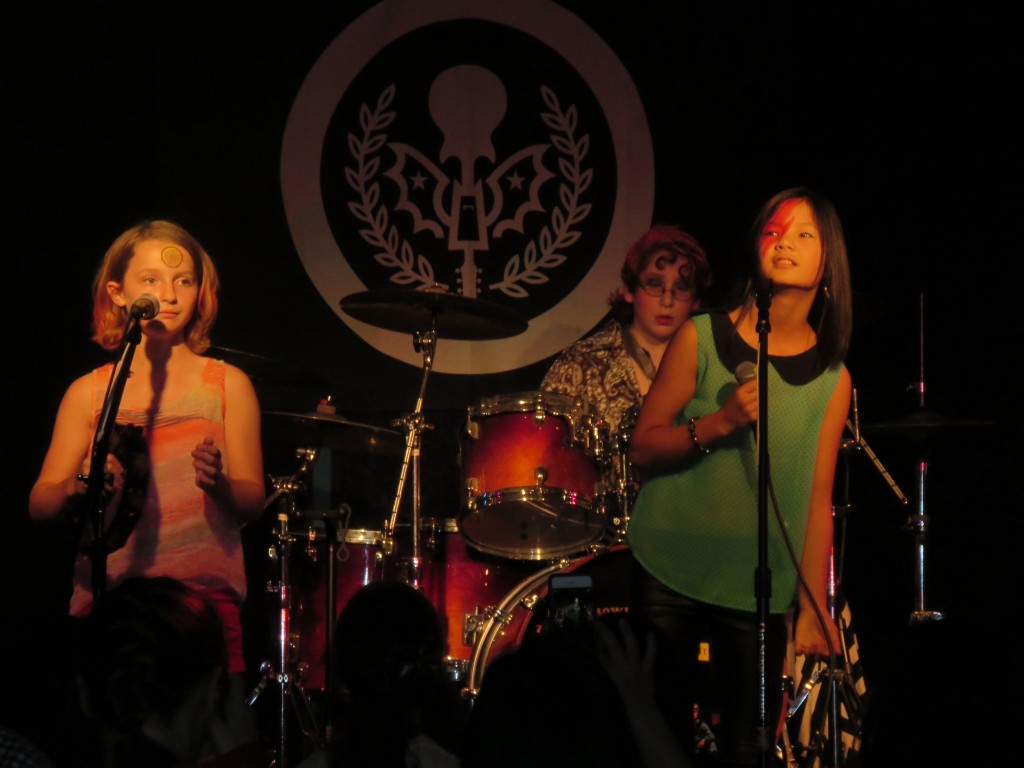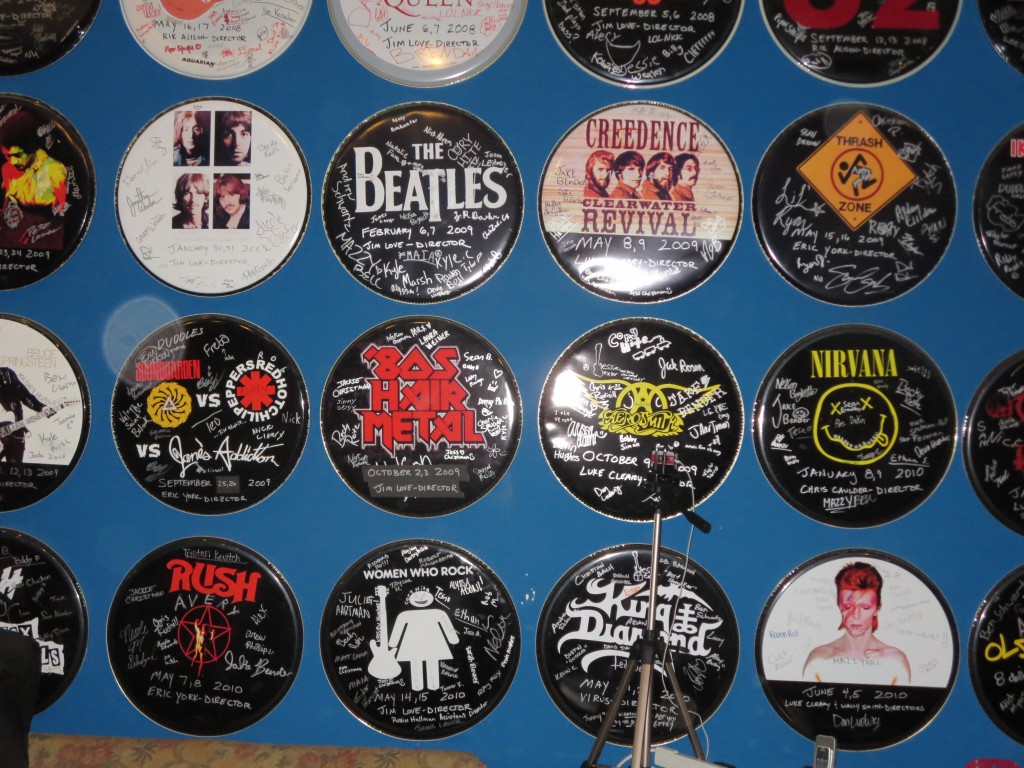Last weekend I saw my nephew play drums in a David Bowie tribute concert at the School of Rock in Fort Washington (a suburb of Philadelphia). Unsurprisingly, I had a blast.
I mean, how could any Bowie fan resist the prospect of watching a rotating ensemble of middle- and high school-aged kids performing a 2+ hour set of Bowie classics? Particularly when the event included a performance of The Rise and Fall of Ziggy Stardust and the Spiders From Mars in its entirety? But also, the event hit the sweetspot between some themes I’ve been considering on this blog: how kids get socialized into musical consumption, and how musical praxis can be embedded in community.
SCHOOL OF ROCK
The School of Rock is probably the best known example in the growing field of music institutes and camps dedicated to teaching kids how to rock — or, specifically, how to play in rock bands. As explained in the documentary Rock School, the first “School of Rock” was first opened in 2002 by Paul Green in downtown Philadelphia (some 15 miles away from the school concert I saw). Thanks to corporate management and the boost of visibility granted by the evidently unrelated Jack Black film School of Rock (2003), the School of Rock is now a growing music education franchise with over 138 locations, including at least 3 in the Philadelphia area.
(Incidentally, Paul Green eventually sold his share of the business and relocated across the Hudson River from me, where he runs the similar Paul Green Rock Academy.)
In addition to music lessons, the centerpiece of the School of Rock’s curriculum is the performance camps and lessons organized around the music of particular artists or themes, concluding with a concert open to the public. That’s how my nephew Ben got involved in the David Bowie concert: having taken drum lessons elsewhere, he signed up for his first session at the Fort Washington School of Rock. For about 2-3 months, he’s been attending weekly 3-hour classes where a group of instructors selected the songs to be performed, assigned students to various songs, and then broke up the class of 17 students into different overlapping ensembles to learn and rehearse a 28-song setlist (!!!).
The walls of the Fort Washington School of Rock’s theater bear over 100 bass drum heads designed with the themes of past concerts. In addition to the classic rock icons (the Beatles, Led Zeppelin, progressive rock) and alt-rock staples (Nirvana, Red Hot Chili Peppers, “women who rock”) you might expect, the programmings reveal one way how a rock muso’s obsessions get transmitted to a new generation. I mean, really, you’re going to organize a program around the music of Steely Dan or Frank Zappa? Or King Diamond? Seeing these kids perform, I’m impressed not only that the students can rise to the level of skill these artists’ repertoire demand, but that there’s enough teenagers in 2014 who want to dive down the rabbithole of an older generation’s tastes. This includes the celebration of “the album as a cohesive, artistic expression” — the idea behind the School of Rock’s on-going “Epic Album” concert series.
In case you’re wondering, I saw exactly one bass drum head dedicated to an obviously Black music form: Old School Rap. Nonetheless, the program indicated they’ve had Rap and Funk events previously. Possibly this overlaps a predictable theme for a School of Rock concert: at least two concerts featuring the music of the Beastie Boys. [update: see the comment below by the Fort Washington School of Rock’s music director.]
LET ALL THE CHILDREN BOOGIE
What does David Bowie mean to kids today? I didn’t get a chance to ask this of anyone besides my nephew, who wasn’t necessarily familiar with Bowie’s work before this School of Rock session. Certainly the School of Rock instructors aren’t shy about explaining the pop-culture significance and musical particularities of their artists (the program notes “Bowie also has one of the most unique and eccentric vocal styles in rock”).
Bowie, specifically Ziggy Stardust-era Bowie, also gives students a license to put on make-up and wear various styles of glitter-rock fashion. As you might expect, it’s awesome to see a group of kids brandishing the Aladdin Sane lightning bolt on their faces. As suggested by the cross-dressing lead singer on “Changes” and the Man Who Sold The World-era frock-wearing bassist on “Lady Stardust,” some of the older kids recognize Bowie as a vehicle for explicit gender-bending.
Of course, it’s unfair to expect from these kids the skills of a professional tribute band, much less the stage presence of Bowie himself or the instrumental standards of a Mick Ronson or Carlos Alomar. Still, the kids brought excitement to their set, which was arranged with almost no guitar solo indulgence and (this was especially appreciated) very tight changes in ensembles between songs. The School of Rock staff made some inspired choices assigning lead vocals between boys and girls as well as vocal ability. I wish I had videorecorded “Young Americans” that night, because it sounds awesome with 5 girls, the oldest probably a high school freshman, handling the background vocals (“Allllll night!”). However, I was on uncle duty that night, so the only songs I taped were the ones with my nephew on drums.
Created with flickr slideshow.



2 comments
Jim Love says:
May 15, 2014
Hi Leonard,
Thanks for attending the show, your support of the SOR & for this well-written blog article! Is it cool if we share this on our social media sites? Ben did great this season, especially after missing several weeks with a broken wrist! Please feel free to attend & write about any of our other shows we do-I can even set up some time for either myself, another staff member, or students to talk with you if you wish!
One small thing I did want to clarify. You may not have seen some of the other drum heads, but we have actually covered a good amount of “Black music” since we’ve been open: two Funk & Reggae shows, a Blues show, Michael Jackson vs. Prince, Motown, and we are doing Philly Rock this summer, which will prominently feature The Roots, TSOP, Digable Planets, Schoolly D, & other city artists. Just wanted to clarify that–hope to see you at other shows in the future!
Leonard Nevarez says:
May 15, 2014
You’re very welcome to share this blog post on any site. And thanks for the update on other shows you’ve done; I’ll be sure to note that above.